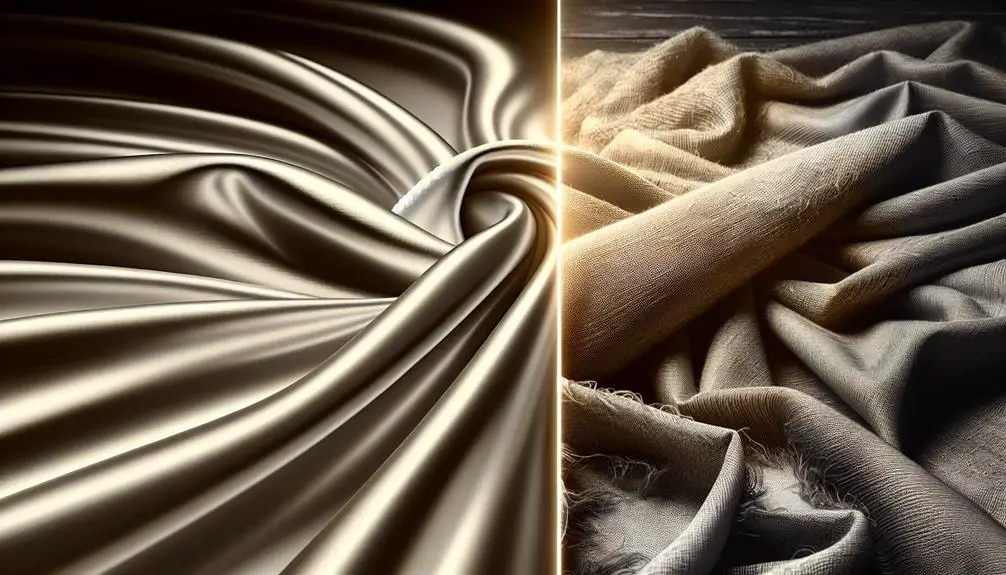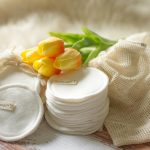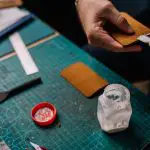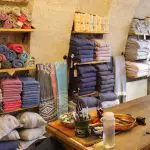I've found that whether rayon is high quality depends on what you're looking for. It's a semi-synthetic fabric made from wood pulp, known for its softness and luxurious feel. It keeps you cool and dry, resists wrinkles, and holds color well, which is great. However, rayon can shrink and isn't the most durable. It also tends to lack stretchability and its production has a notable environmental impact. So, while it's got some fantastic benefits, there are a few drawbacks. Considering everything could give you a clearer picture of rayon's place in a sustainable wardrobe.
Table of Contents
Key Takeaways
- Rayon is valued for its soft texture and luxurious feel on the skin.
- It features moisture-wicking properties that help keep the wearer cool and dry.
- Rayon's color retention is long-lasting, ensuring vibrant and durable hues.
- The fabric is wrinkle-resistant, reducing the need for frequent ironing.
- It is versatile, suitable for a variety of clothing styles and applications.
What Is Rayon?
What exactly is rayon? Well, let me break it down for you. Rayon is a semi-synthetic fabric, which means it's not entirely natural like cotton, nor is it fully synthetic like polyester. It's made from purified cellulose fibers, primarily derived from wood pulp. This makes it somewhat unique in the fabric world.
The process of creating rayon is quite fascinating. It starts with wood, which is crushed into pulp. This pulp is then bleached and dissolved to form a viscous solution. The magic happens when this solution is spun into yarns, which can then be woven or knitted into the soft, luxurious fabric we know as rayon.
This fabric is a hit in the fashion industry because of its comfort and luxurious feel. It drapes beautifully, making it perfect for flowy dresses, comfortable shirts, and much more. Despite its softness, it's pretty versatile, popping up in everything from elegant evening wear to cozy children's clothes. In short, rayon is a standout fabric that combines the practicality of man-made materials with the comfort and luxury of natural fibers.
Benefits of Rayon
After exploring what rayon is, let's look at why it's such a great choice for many garments. Known as viscose, rayon is not just soft and comfortable; it also offers a luxurious, elegant appearance ideal for a variety of clothing styles. Its ability to absorb moisture and stay cool makes it perfect for warmer climates, keeping you comfortable throughout the day.
Here's a quick table that illustrates some vivid benefits of rayon:
| Quality | Benefit | Why It Matters |
|---|---|---|
| Moisture-wicking | Keeps you cool and dry | Essential for comfort in warmth |
| Wrinkle-resistant | Minimal maintenance needed | Saves time and effort |
| Color retention | Clothes look new and vibrant longer | Great for long-term use |
| Soft texture | Feels luxurious and gentle on the skin | Enhances wearer comfort |
This fabric isn't just about looking good; it's about feeling good too. The chemicals used in its production are key to ensuring rayon remains sustainable and retains these qualities over time. So, when you're choosing an outfit that's both stylish and practical, rayon stands out as a smart, sophisticated choice.
Disadvantages of Rayon
Despite its benefits, rayon has several drawbacks that might make you think twice before choosing it for your wardrobe. Here's why:
- Shrinkage and Durability Concerns
- Rayon is notorious for its tendency to shrink. Tossing it into the washing machine might mean you'll end up with a garment significantly smaller than its original size. Plus, it weakens when wet, making it susceptible to tearing or stretching out of shape during routine washes.
- Lack of Stretchability
- If you're looking for comfort and flexibility in your clothing, rayon might disappoint. Its lack of stretchability can make it less comfortable for active wear or any clothing that requires a bit of give.
- Environmental Impact
- The production of rayon is chemical-intensive and typically unsustainable, posing significant concerns for eco-conscious consumers. While EcoVero offers a more sustainable alternative, traditional rayon still dominates the market, contributing to environmental degradation.
Considering these points, it's crucial to weigh the pros and cons of incorporating rayon into your wardrobe, especially if sustainability and durability are top priorities for you.
Rayon Production Process
Let's talk about how rayon is made, starting with where it comes from.
The process kicks off with raw materials like wood pulp, which is then treated and spun into fiber through a series of chemical reactions.
We also need to consider the environmental effects of these chemicals, as they can be pretty harsh on our planet.
Raw Materials Sources
Rayon's journey begins with natural materials like wood pulp, cotton linters, and bamboo, which are key to its production process. These sources are rich in cellulose, the essential component for making rayon. Here's how these raw materials add up:
- Wood Pulp: Mostly derived from trees like beech and pine, wood pulp is a primary source of cellulose.
- Cotton Linters: These are the short fibers left after cotton seeds are processed. They're highly cellulose-rich.
- Bamboo: Known for its quick growth, bamboo provides another sustainable source of cellulose.
These plant matters are processed into filament fibers, ensuring that rayon remains a versatile fabric choice, adaptable in both fiber length and type.
Spinning and Regeneration
In the rayon production process, we first dissolve cellulose fibers in chemicals, which are then spun into yarn through an intricate spinning and regeneration stage.
Here's how it works: the cellulose fibers are dissolved in a solvent, creating a viscous solution. This solution is then forced through a spinneret, a device much like a showerhead, which shapes the solution into fine threads. Once these threads emerge, they solidify into rayon filaments.
The whole process transforms these natural components into yarn that's ready for fabric-making. This method not only allows us to produce soft and luxurious fabrics but also gives rayon its well-loved drape and breathability.
It's pretty fascinating how spinning and regeneration turn simple cellulose into something so elegant!
Environmental Impact Considerations
The chemical-intensive process of producing rayon raises significant environmental concerns. As I delve deeper into how rayon, a semi-synthetic fiber, impacts our planet, I can't help but feel alarmed. Here's a quick breakdown:
- Chemical Release: The transformation from plant pulp to silky threads involves chemicals that often find their way into our air and water, negatively affecting local ecosystems.
- Wood Sourcing: The trees used to create rayon sometimes come from endangered forests. This unsustainable practice raises crucial questions about the future of these vital habitats.
- Health Risks: Workers face hazards from the chemical treatments, a stark reminder of the human cost of our fashion choices.
Understanding these issues is essential for anyone passionate about sustainable fabric and environmental impact assessments.
Types of Rayon Fabrics
When we look at the different types of rayon, there's a lot to consider.
Viscose rayon varieties often vary in quality, but modal and lyocell stand out for their unique properties.
It's interesting to see how modal's strength compares to lyocell's sustainability features.
Viscose Rayon Varieties
Several types of rayon fabrics, each with unique qualities, are widely used in the fashion industry.
- Viscose Rayon: It's the most common type, similar to cotton. It shines for its breathability and moisture absorption, making it a staple in everyday fashion.
- Modal Rayon: This fabric is derived from beech trees and is celebrated for its softness and strength. It's a go-to for items that need to be both comfortable and durable.
- Lyocell (including TENCEL): Known for its robust, moisture-wicking properties, lyocell is a standout for active wear. TENCEL, a specific brand of lyocell, is additionally praised for its sustainable production and biodegradability.
Each type offers a specific blend of qualities that cater to different needs within the fashion realm.
Modal and Lyocell Differences
Diving into the differences between Modal and Lyocell, both are standout types of Rayon, yet they cater to varied fabric needs due to their distinct properties. Modal, derived from beech trees, is celebrated for its incredible softness and strength, making it a favorite for comfy clothing. Lyocell, also from natural sources, excels in durability and moisture management, ideal for active wear.
Here's a quick comparison to help clarify:
| Feature | Modal | Lyocell |
|---|---|---|
| Source | Beech trees | Wood pulp |
| Softness | Very soft | Soft |
| Strength | Strong | Very strong |
| Moisture-wicking | Moderate | Excellent |
| Sustainability | Sustainable | Highly sustainable |
Both prioritize sustainable production, but Lyocell's process is particularly eco-friendly, aligning with high environmental standards.
Rayon in Fashion Industry
Rayon is a popular choice in the fashion industry for its versatility and luxurious feel. As someone who's deeply interested in fashion, I've noticed that rayon fabric really stands out. It's soft, which makes it incredibly comfortable to wear. Its absorbent nature means it's a go-to for warm weather clothes, keeping the wearer cool and relaxed. Plus, its versatility allows designers to unleash their creativity, producing everything from casual to high-end styles.
Here's how rayon makes its mark in fashion:
- Tunics and Dresses: Rayon's flowy nature is perfect for making tunics and dresses that drape beautifully. The fabric's softness adds to the comfort, making it ideal for both daily wear and special occasions.
- Lingerie and Shirts: The softness and absorbency of rayon are exactly what you want in intimate wear and everyday shirts. It feels luxurious against the skin, elevating the basic pieces in your wardrobe.
- Lining Material: Many designers use rayon as a lining material. It adds an extra layer of comfort and luxury, making garments feel as good as they look.
In the fashion world, rayon truly brings together comfort and style, making it a cherished choice for designers and consumers alike.
Caring for Rayon Garments
Caring for rayon garments properly can significantly extend their life and keep them looking fresh. As a lover of fabrics, I've learned that how you wash and dry rayon can make a big difference. Unlike cotton, rayon isn't as straightforward due to its delicate nature. It's made from natural fibers, so it requires gentle handling to maintain its shape and texture.
Here's a simple table to guide you:
| Action | Setting | Note |
|---|---|---|
| Wash | Max 30°C, wool/silk | Check labels for specifics |
| Dry | Tumble dry on low | Helps prevent shrinking |
| Iron | Low temperature | Avoid scorching |
| Alternative | Handwash | Prevents stretching |
| General Care | Follow care labels | Essential for longevity |
I always check the care label first, as it often has crucial information specific to the garment. Handwashing is my go-to method, especially for those pieces I really cherish. It keeps them from stretching out like some other fabrics might. And when it comes to ironing, a low heat setting is key to avoid any damage. Following these tips will help you keep your rayon garments in top-notch condition.
Rayon Versus Cotton
When weighing the merits of rayon against cotton, it's clear that each fabric offers distinct advantages depending on the wearer's needs. Rayon, with its luxury appearance and soft, comfortable feel, seems ideal for those who prioritize aesthetics and comfort in their clothing choices. On the other hand, cotton appeals for its durability and ability to handle moisture without weakening.
Here's how I'd break down their features:
- Luxury Appearance and Feel: Rayon truly shines in how it drapes and feels against the skin, mimicking more luxurious fabrics like silk. Its softness and slight sheen make it a popular choice for high-end fashion where visual appeal and comfort are paramount.
- Moisture Management: While both fabrics are moisture absorbent, rayon stands out for staying cool and comfortable even in humid conditions, making it perfect for summer wear.
- Durability and Maintenance: Cotton takes the lead in durability. It's stronger when wet and can handle heat well, making it ideal for items that require frequent washing and use, such as towels and everyday wear.
Environmental Impact of Rayon
When we talk about the environmental impact of rayon, there are a few key points to consider. First, the production of rayon releases harmful pollutants into the air and water, which is a major concern.
Additionally, it uses a lot of resources, including wood from trees, and isn't easy to recycle, which complicates efforts to make the fashion industry more sustainable.
Rayon Production Pollutants
Rayon's production unleashes numerous pollutants, including toxic chemicals like carbon disulfide, which seriously harm our environment. The chemicals used, such as sulfuric acid and carbon disulfide, aren't just bad news for our planet; they're dangerous for us too.
Here's what I've learned about the pollutants from making rayon:
- Toxic Air Emissions: Carbon disulfide is released into the air, contributing to environmental pollution and causing severe health issues like neurological damage.
- Water Contamination: Chemical waste from rayon production often ends up in our waterways, harming aquatic life and ecosystems.
- Soil Pollution: Residual chemicals can seep into the soil, disrupting plant life and further degrading natural habitats.
Thankfully, there's an alternative: Tencel, which is way gentler on our environment.
Resource Consumption
The production of rayon not only releases harmful pollutants but also consumes a huge amount of resources, especially water. On average, making just one kilogram of rayon guzzles between 50-85 liters of water. This massive water usage isn't the only concern. The chemicals used in the manufacturing process, like carbon disulfide, pose serious environmental risks if mishandled.
| Aspect | Impact |
|---|---|
| Water Usage | 50-85 liters per kg of rayon |
| Deforestation | Leads to loss of biodiversity |
| Emissions | Releases hazardous substances |
Besides, deforestation linked to sourcing wood pulp further hurts our ecosystems. And let's not forget the hazardous emissions released into our air and water. The environmental impact of rayon is indeed significant.
Biodegradability and Recycling
Despite these environmental concerns, it's worth noting that rayon is biodegradable and can be recycled. Here's a quick rundown on how that helps:
- Naturally Decomposes: Rayon breaks down over time because it's made from cellulose fibers. These fibers are food for microorganisms, so they don't stick around in landfills forever.
- Recycling Options: Whether through mechanical or chemical processes, recycling rayon means we can turn old clothes into new ones without needing fresh resources. This supports sustainable practices big time.
- Circular Economy Friendly: By choosing rayon, we're backing a system where materials are reused continuously. This reduces waste and minimizes our environmental footprint, making it a smart pick for the planet.
Future of Rayon Fabric
Looking ahead, rayon fabric is set to become more sustainable with innovations like EcoVero and improvements in production methods. Sustainable advancements are really shaping how we think about what we wear. With the push towards environmental responsibility, materials like EcoVero are stepping up. They're not just about being eco-friendly; they're about making rayon tougher and more flexible, which means your clothes could last longer and fit better.
These innovations also focus on reducing the environmental impact. By developing closed-loop production methods, the industry aims to minimize waste and reuse resources. This doesn't just help the planet; it makes economic sense too. And let's talk transparency — knowing where and how your clothes are made is becoming a big deal. Consumers today want to be sure their fashion choices don't harm the planet.
What's really exciting is seeing how these changes make rayon not just a better choice for the environment, but a smarter choice for consumers. You're getting quality, durability, and the peace of mind that comes with sustainable choices. The future of rayon looks bright, and it's something I'm keeping an eye on as we move towards more responsible fashion.
Frequently Asked Questions
Is Rayon Cheap Quality?
I wouldn't say rayon is cheap quality; it's actually quite luxurious and comfortable. It strikes a good balance between affordability and quality, making it a popular choice in the fashion industry.
Is Rayon a Luxury Fabric?
I'd say rayon's considered a luxury fabric because of its softness, elegant drape, and comfort. However, it's not as durable or sustainable as other fabrics, which can affect its overall quality.
Is 100% Rayon a Good Fabric?
I think 100% rayon is a solid choice for fabric because it's soft and luxurious, but it's not very stretchy and you've got to be careful washing it since it can shrink easily.
Which Is Better Rayon or Cotton?
I'd say it depends on your needs. Cotton's durable and great for heat, while rayon's absorbent with a cool feel and elegant drape. Both have their merits depending on the garment's purpose.
- Outdoor Scrim Fabric: Choosing Weather-Resistant Materials - June 26, 2025
- A Guide to Chinese Laid Scrims for Industrial Applications - June 26, 2025
- Why Museums Use Sheer Scrim Fabric for Exhibits and Displays - June 26, 2025






